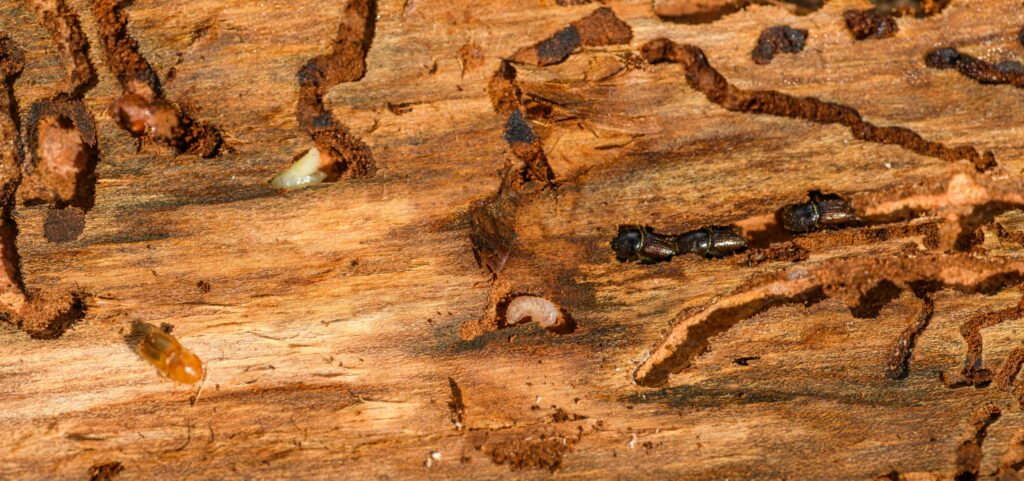When you notice wood damage in your home, it’s natural to assume termites are the cause. But carpenter ants can create very similar problems. Both pests weaken wood, spread rapidly, and can lead to costly repairs if left unattended.
Knowing whether you’re dealing with carpenter ants or termites makes all the difference. Misidentifying them means wasted time, money, and even more damage to your property.
This guide explains how to identify termites or carpenter ants, the signs to look for, and why professional pest control is the most effective solution.
Why It’s Important to Know the Difference
Carpenter ants and termites both attack wood, but they do it in very different ways. Carpenter ants hollow out wood to build nests, while termites eat it as food. Because of this, the treatments used to eliminate them are not the same.
If you mistake one pest for the other, you could invest in the wrong solution. By learning the unique signs of each, you can act fast and protect your home from further damage.
With that in mind, let’s look at how you can recognize the two pests and what sets them apart.
Carpenter Ants vs. Termites: 3 Key Differences
Carpenter ants or termites? At first glance, they might look alike, but a closer look reveals several distinct features. Identifying the insect itself is the first step before inspecting the type of damage left behind.
Physical Appearance:
- Carpenter ants: Narrow waist, elbowed antennae, and often larger in size (up to ½ inch).
- Termites: Straight waist, straight antennae, and a more uniform body shape.
Wings:
- Carpenter ants: Front wings are noticeably longer than their back wings.
- Termites: Both pairs of wings are equal in length.
Color:
- Carpenter ants: Usually black or dark red.
- Termites: Pale, creamy white to light brown.
Once you know what each pest looks like, the next step is to check for signs of damage. The type of destruction they leave behind tells an even clearer story.
3 Signs of Carpenter Ant Damage
Carpenter ants don’t eat wood. Instead, they tunnel through it to create smooth, polished galleries for nesting. Because they don’t consume the wood, the damage tends to look cleaner compared to termite activity.
Warning signs include:
- Small piles of sawdust-like material (frass) near walls, windows, or furniture.
- Rustling noises inside the walls, especially at night.
- Large black ants are spotted in kitchens, bathrooms, or outside near wood.
If you’ve seen these warning signs, you may not be dealing with termites at all, but the risk is still serious. Now, let’s compare this with what termite damage looks like.
4 Signs of Termite Damage
Catching these issues early is key to preventing further destruction. Understanding the specific signs of termite activity will help you take the right steps toward protecting your property. Unlike carpenter ants, termites feed on wood, making them far more destructive. Their colonies can go unnoticed for months (or even years) before the damage becomes obvious.
Look out for:
- Wood that sounds hollow when tapped.
- Mud tubes can be lurking along your foundation or crawl spaces.
- Discarded wings near windowsills, doors, or basements.
- Bubbling or uneven paint may point to hidden termite activity.
The difference is clear: termites actually consume the wood, while carpenter ants carve through it. So how can you tell which one is affecting your home right now?
How to Know if You Have Termites or Carpenter Ants
A clear understanding of their distinct behaviors and the damage they inflict is crucial for effective pest management. By focusing on these key indicators, you can gain a much clearer picture of the intruder you’re facing. If you’re still not sure, here are some quick ways to tell the difference:
- Check the wood: Carpenter ants leave smooth, sanded tunnels. Termites leave rough, soil-filled ones.
- Look for frass: Carpenter ants leave behind wood shavings and debris. Termites do not.
- Search for mud tubes: Only termites build these protective pathways.
If you’re asking yourself how to know if you have termites or carpenter ants, these clues will give you a strong indication. But when in doubt, there’s only one way to be 100% sure—and that’s a professional inspection.
Why Professional Pest Control Is Essential
DIY sprays and traps may offer temporary relief, but they rarely eliminate colonies of carpenter ants or termites. These pests often hide deep inside walls, attics, or foundations where store-bought solutions can’t reach.
At Action Pest Control, we provide:
- Thorough inspections to identify the exact pest.
- Targeted treatment plans that address both visible activity and hidden colonies.
- Long-term prevention strategies to keep your home safe year-round.
Learn more about our termite control services and carpenter ant control solutions.
Once you understand the risks and the importance of professional help, the next step is simple—take action before the damage spreads.
Protect Your Home with Action Pest Control
Both carpenter ants and termites can cause serious damage if left untreated. The sooner you act, the easier it is to protect your home and avoid costly repairs.
If you suspect you have termites or carpenter ants, don’t wait until the problem gets worse. Contact Action Pest Control today for a professional inspection and a customized treatment plan designed to stop the damage fast.
FAQs About Carpenter Ants and Termites
Are carpenter ants worse than termites?
Not necessarily. Carpenter ants can cause damage by hollowing out wood, but termites are generally more destructive because they eat wood as food. Termites can cause structural issues faster if left untreated.
Can carpenter ants damage a home like termites?
Yes, carpenter ants can weaken wooden beams, furniture, and structures over time. While they don’t eat the wood, their tunneling can still compromise the strength of your home.
What should I do if I can’t tell whether I have termites or carpenter ants?
If you aren’t certain, call a pest control professional. Misidentifying the pest can lead to wasted money on the wrong treatment. A professional inspection ensures the problem is handled correctly from the start.



